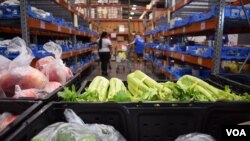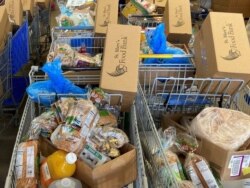A food pantry in Fairfax, Virginia, serves as a lifeline for Mandy Recinos in her constant struggle to feed her three children.
“They help me fill some of the holes in my food budget by giving me meat and produce I can’t afford to buy,” Recinos said, as she picked up a couple of boxes of groceries at Food for Others.
That need has been exacerbated by rising food prices that are among the most broadly felt indicators of rising inflationary pressures in the United States, blamed on widespread worker shortages, surging transportation costs and supply chain issues, among other factors.
According to the U.S. Bureau of Labor Statistics, grocery prices rose an average of 3.5% over the last year. Meat prices today are among the highest on record, and the cost of food is not expected to dip anytime soon.
The soaring prices are “putting additional difficulties on families, because all of a sudden, they can’t buy as much as they could before,” explained Jason Jakubowski, chief executive officer at the Connecticut Food Bank.
Higher prices are affecting not just financially strapped families but also food banks and relief groups that provide them with groceries.
“The high prices are costing us more to feed a family in need,” said Alison Padget, development and outreach director at Food for Others. “We’ll have to rethink our purchasing decisions, because economists say the prices are going to be high for at least a year.”
“We’re already spending a lot more on food than we have in years past,” said Greg Trotter, a spokesman for the Greater Chicago Food Depository, a large food bank. “Our food purchasing budget has doubled this year.”
Some clients of food banks and pantries say without them, they would struggle to have enough to eat since government food assistance only goes so far.
Naomi Cherino, a frequent client at Food for Others, said she gets government food assistance and received federal stimulus payments during the pandemic. Even so, she said, it is challenging to find enough money to keep her family fed.
“I have two growing teenagers who eat a lot,” she said.
Stimulus money spent
As the stimulus money runs out, food assistance organizations worry they may be getting a new influx of hungry people looking for help.
“Maybe people have a little more cash because of the government subsidies, and that has kept them afloat,” Jerry Brown, director of public relations at St. Mary’s Food Bank in Phoenix, Arizona, told VOA. But “there could be a problem down the road” once federal funding has ended, he added.
The problem has already begun at the Community Food Bank of New Jersey, which covers a large portion of the mid-Atlantic state. Impact leader Triada Stampas said the organization is serving more clients now than at the height of the pandemic due to “sticker shock” at grocery stores.
The financial strain is also apparent among those served by the Father English Food Pantry in Paterson, New Jersey, according to program director Carlos Roldan.
“A lot of clients lost their jobs during the pandemic, and those that are employed only make minimum wage,” Roldan said. “And when they go to the grocery store, they don’t have enough money to buy everything they need.”
Mixed picture for now
But the picture is far from uniform. Some relief groups say rising food prices haven’t had a major impact on them yet. That’s because donors continue to supply most of their food, or supplies have already been purchased in bulk that will last for several months.
“But we already see the price changes will affect us soon,” said Kelly Mott, external affairs director at the Mississippi Food Network. “We are in the process of buying turkeys for the Thanksgiving holiday in November. And since they are so expensive, we won’t be able to purchase as many as we usually do, especially for the families with children who rely on us.”
Stampas said the skyrocketing cost of food is a “warning sign” that food insecurity may grow even more in United States, one of the world’s biggest producers and exporters of agricultural goods.
The coronavirus pandemic exacerbated food insecurity, she said, and now, higher prices are making it even harder for people “struggling to put food on the table.”













